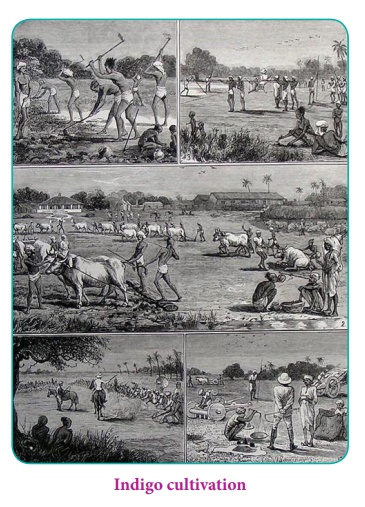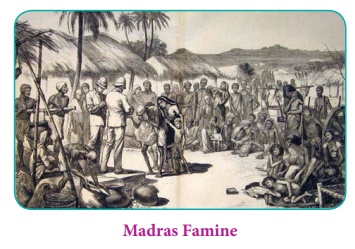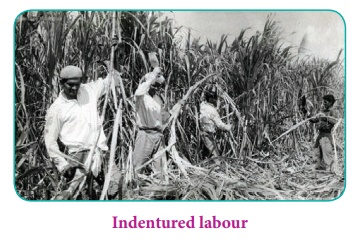Rise of Nationalism in India | History - Socio-economic Background | 12th History : Chapter 1 : Rise of Nationalism in India
Chapter: 12th History : Chapter 1 : Rise of Nationalism in India
Socio-economic Background
Socio-economic Background
(a) Implications of the New Land Tenures
The
British destroyed the traditional basis of Indian land system. In the
pre-British days, the land revenue was realised by sharing the actual crop with
the cultivators. The British fixed the land revenue in cash without any regard
to various contingencies, such as failure of crops, fall in prices and droughts
or floods. Moreover, the practice of sale in settlement of debt encouraged
money lenders to advance money to landholders and resorting to every kind of
trickery to rob them of their property.
There
were also two other major implications of the new land settlements introduced
by the East India Company. They institutionalised the commodification of land
and commercialisation of agriculture in India. As mentioned earlier, there was
no private property in land in pre-British era. Now, land became a commodity
that could be transferred either by way of buying and selling or by way of the
administration taking over land from holders, in lieu of default on payment of
tax/rent. Land taken over in such cases was auctioned off to another bidder.
This created a new class of absentee landlords who lived in the cities and
extracted revenue from the lands without actually living on the lands. In the
traditional agricultural set-up, the villagers produced largely for their
consumption among themselves. After the new land settlements, agricultural
produce was predominantly for the market.
The
commodification of land and commercialisation of agriculture did not improve
the lives and conditions of the peasants. Instead, this created discontent
among the peasantry and made them restive. These peasants later on turned
against the imperialists and their collaborators.
(b) Laissez Faire Policy and De-industrialization: Impact on Indian Artisans
The
policy of the Company in the wake of Industrial Revolution in England resulted
in the de-industrialization of India. This continued until the beginning of the
World War I. The British Government pursued a policy of free trade or laissez faire. Raw materials like
cotton, jute and silks from India were taken to Britain.
The
finished products made from those raw materials were then transported back to
the Indian markets. Mass production with the help of technological advancement
enabled them to flood the Indian market with their goods. It was available at a
comparatively cheaper price than the Indian handloom cloth. Prior to the arrival
of the British, India was known for its handloom products and handicrafts. It
commanded a good world market. However, as a result of the colonial policy,
gradually Indian handloom products and handicrafts lost there market, domestic
as well as international. Import of English articles into India threw the
weavers, the cotton dressers, the carpenters, the blacksmiths and the
shoemakers out of employment. India became a procurement area for the raw
material and the farmers were forced to produce industrial crops like indigo
and other cash crops like cotton for use in British factories. Due to this
shift, subsistence agriculture, which was the mainstay for several hundred
years, suffered leading to food scarcity.

The
Indigo revolt of 1859 – 60 in Bengal was one of the responses from the Indian
farmer to the oppressive policy of the British. Indian tenants were forced to
grow indigo by their planters who were mostly Europeans. Used to dye the
clothes indigo was in high demand in Europe. Peasants were forced to accept
meagre amounts as advance and enter into unfair contracts. Once a peasant
accepted the contract, he had no option but to grow indigo on his land. The
price paid by the planter was far lower than the market price. Many a times,
the peasants could not even pay their land revenue dues. Hoping that the
authorities would address their concerns, the peasants wrote several petitions
to authorities and organised peaceful protests. As their plea for reform went
in vain, they revolted by refusing to accept any further advances and enter
into new contracts. Peasants, through the Indigo revolt of 1859-60, were able
to force the planters to withdraw from northern-Bengal.
(c) Famines and Emigration of Indians to Overseas British Colonies
Famines
As India
became increasingly de-industrialised and weavers and artisans engaged in
handicrafts were thrown out of employment, there were recurrent famines due to
the neglect of irrigation and oppressive taxation on land. Before the arrival
of the British, Indian rulers had ameliorated the difficulties of the populace
in times of famines by providing tax relief, regulating the grain prices and
banning food exports from famine-hit areas. But the British extended their
policy of non-intervention (laissez faire) even to famines. As a result,
millions of people died of starvation during the Raj. It has been estimated
that between 1770 and 1900, twenty five million Indians died in famines.
William Digby, the editor of Madras Times, pointed out that during 1793-1900
alone an estimated five million
people had died in all the wars around the world, whereas in just ten years
(1891-1900), nineteen million had died in India in famines alone.
Sadly
when people were dying of starvation millions of tonnes of wheat was exported to Britain. During the 1866
Orissa Famine, for instance, while a million and a half people starved to
death, the British exported 200 million pounds of rice to Britain. The Orissa
Famine prompted nationalist Dadabhai Naoroji to begin his lifelong
investigations into Indian poverty. The failure of two successive monsoons
caused a severe famine in the Madras Presidency during 1876-78. The viceroy
Lytton adopted a hands-off approach similar to that followed in Orissa. An
estimated 3.5 million people died in the Madras presidency.

Indentured
Labour
The
introduction of plantation crops such as coffee, tea and sugar in Empire
colonies such as Ceylon (Sri Lanka), Mauritius, Fiji, Malaya, the Caribbean
islands, and South Africa required enormous labour. In 1815, the Governor of
Madras received a communication from the Governor of Ceylon asking for
“coolies” to work on the coffee plantations. The Madras Governor forwarded this
letter to the collector of Thanjavur, who reported that the people were very
much attached to the soil and unless some incentive was provided it was not
easy to make them move out of their native soil. But the outbreak of two
famines (1833 and 1843) forced the people, without any incentive from the government,
to leave for Ceylon to work as coolies in coffee and tea plantations under the
indentured labour system. The abolition of slavery in British India in 1843
also facilitated the processes of emigration to Empire colonies. In 1837 the
number of immigrant Tamil labourers employed in Ceylon coffee estate was
estimated at 10,000. The industry developed rapidly and so did the demand for
Tamil labour. In 1846 its presence was estimated at 80,000 and in 1855 at
128,000 persons. In 1877, the famine year, there were nearly 380,000 Tamil
labourers in Ceylon.

Besides
Ceylon, many Indians opted to emigrate as indentured labour to other British
colonies such as Mauritius, Straits Settlements, Caribbean islands, Trinidad,
Fiji and South Africa. In 1843 it was officially reported that 30,218 male and
4,307 females had entered Mauritius as indentured labourers. By the end of the
century some 5,00,000 labourers had moved from India to Mauritius.
Indentured Labour: Under this penal contract
system (indenture), labourers were hired for a period of five years and
they could return to their homeland with passage paid at the end. Many
impoverished peasants and weavers went hoping to earn some money. It turned out
to be as worse than slave labour. The colonial state allowed agents (kanganis) to trick or kidnap indigent
landless labourers. The labourers suffered terribly on the long sea voyages and
many died on the way. The percentage of deaths of indentured labour during
1856-57, in a ship bound for Trinidad from Kolkata is as follows: 12.3% of all
males, 18.5% of the females, 28% of the boys 36% of the girls and 55% of the
infants perished.
Related Topics